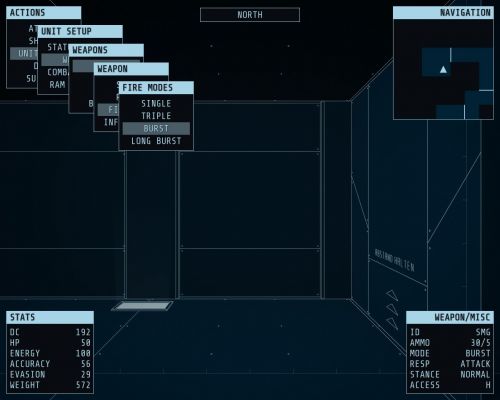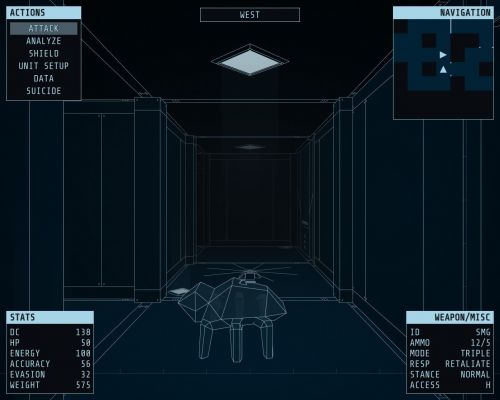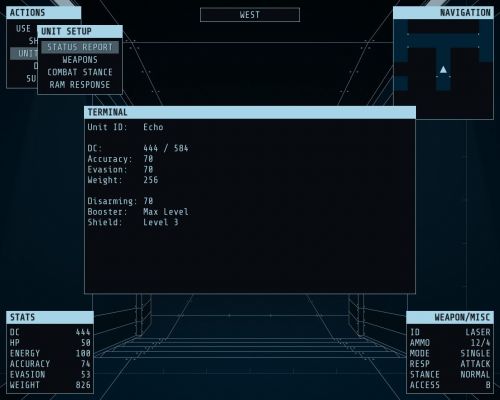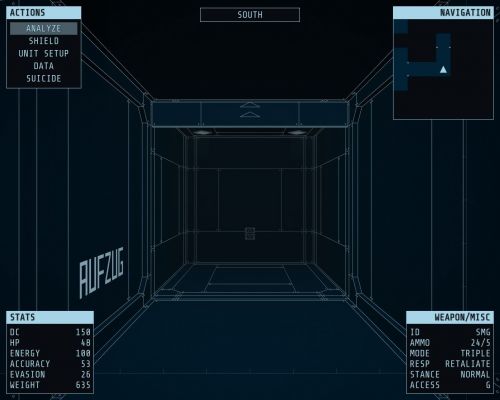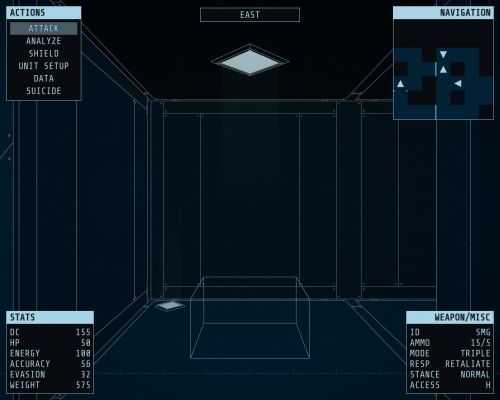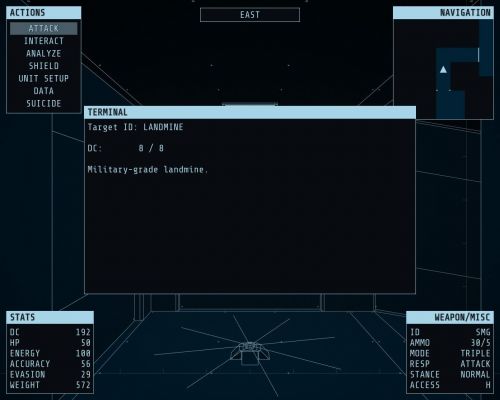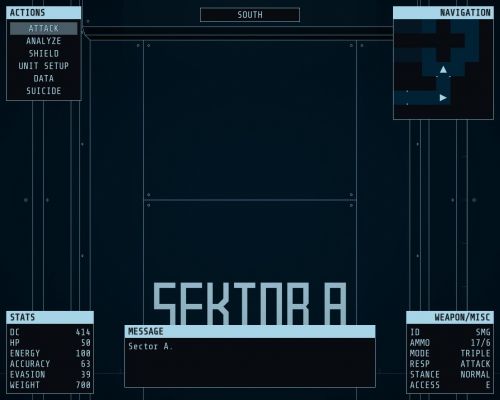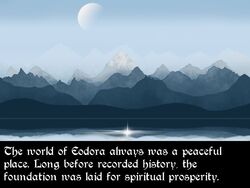RPG Codex Review: Der Geisterturm
RPG Codex Review: Der Geisterturm
Codex Review - posted by Infinitron on Sat 8 February 2020, 22:10:09
Tags: Der Geisterturm; Graverobber Foundation[Review by Darth Roxor]
Der Geisterturm
Barely a year after releasing Das Geisterschiff, Graverobber Foundation returns with Der Geisterturm – a “spin-off in the same setting”, which is a very convenient way of saying, “I like to reuse all the assets I can.” Not that there’s anything wrong with that.
Das Geisterschiff was an interesting game, even if not particularly big, and it showed a lot of potential for future improvements that could be applied to the formula. Thus I was curious how Der Geisterturm would compare to its predecessor, though my expectations were still modest given the short development time. I assumed that the game would be nothing more, and nothing less, than a Geisterschiff++, with largely the same gameplay and feel, but with certain enhancements to the mechanics or usability added on top. Like an expansion pack of sorts. Let us see whether this was the case.
I will be making a lot of comparisons to Geisterschiff here, so if you’re not familiar with that game, you might want to read my review of it for context.
Der Stürmer
Most, if not all, of the new things in Der Geisterturm are related to combat mechanics. The game expands the combat system pretty well when it comes to the tactics available to the player. Back in Geisterschiff, you were more or less limited to just picking the right weapon for the job, and that was it. Geisterturm builds on this by introducing damage types, fire modes and pilot stances.
Your arsenal remains the same – a submachine gun, an assault rifle, a laser gun and a bazooka. However, it is effectively expanded thanks to the fact that the laser gun is now an actual weapon and not just a glorified mine defusing tool. Still, all the weapons retain their original quirks and applications, but there are some new functionalities and mechanics that make it a bit less obvious which gun is the best to pick for a specific encounter. First of all, they differ in damage types (kinetic, energy, explosive), and certain enemies may exhibit resistances to these, so it’s no longer a no-brainer to blast a strong enemy with the bazooka, since he might have a high resistance to explosive damage.
Next up are fire modes. You can now specify the rate of fire for your guns, which influences accuracy, damage done and ammo consumption in obvious ways, but you can also select special fire modes like a charged shot for the laser gun or a critical crack shot for the assault rifle. Often, it’s also wise to combine a specific fire mode with the right combat stance. You can now choose between aiming (accuracy bonus, dodge penalty), normal (balanced) and evasive (dodge bonus, accuracy penalty) stances. For example, a glass cannon enemy is best dispatched with a critical rifle shot on aiming stance, while another foe that sprays you with minigun fire could call for an evasive approach.
All this lets you fiddle a lot with your approach to individual combat encounters, especially since some of the fire modes also require you to remain stationary, so you can’t combine shooting with movement. And staying on the move in combat is very important in Geisterturm, because unlike its predecessor, you can now face more than just one enemy at a time. Typically it’s going to be two enemies, sometimes even three, and certain “boss showdowns” will downright swarm you with baddies. And considering that the fights often take place in narrow corridors, where it’s easy to get surrounded, cut off and backstabbed for terrible damage, remaining stationary can be a death sentence. Still, if you’re feeling very brave, you can actively seek to be surrounded and pray for good dodge rolls, so the enemies miss you and instead shoot each other as their bullets fly wild. But I wouldn’t call it a particularly reliable strategy.
The enemies themselves haven’t changed much, they still mostly operate on a simple basis of “seek and destroy”, but they are less likely to lose interest in the chase now compared to Geisterschiff. Whereas before you could just dance around a pillar and wait for the enemy to go away, now you have to make some effort to hide from them effectively. Still, there is one AI-related aspect that took a bit of a dive. Namely, the enemy attitude towards mines. In Geisterschiff, some enemies would take an effort to clear mines standing in their way, so that they wouldn’t trigger them and get killed. But in Geisterturm, they are all very happy to stomp through every mine in existence, paying them absolutely no heed.
This can take some extreme forms – I found that it is often profitable to begin combat by just passing the turn multiple times if it’s initiated in a larger area, because you can be sure that the enemies will clear the entire room (and more) for you of all the mines before they even get to see you. There was also one absurd instance of this that I simply can’t not mention, even though it has supposedly been fixed already, but it just illustrates the issue all the better. In one big showdown, the boss enemy lost interest in fighting me and instead left the combat area to aimlessly prowl the entire level. As he was doing it, he kept triggering all the leftover mines around the place, until he finally killed himself, and I could progress to the next stage, with a level-up to boot for defeating this deadly foe.
There are also two statistics that have been added – pilot health and combat suit energy. Their initial maximum values stay on the same level throughout the game and can’t be increased, though utilities that feed off energy can be upgraded for lower consumption. Health is tracked in addition to suit armour and has a chance to go down the lower your armour becomes, but ultimately I see little purpose behind adding it. Usually you don’t start taking health damage until your armour reaches critically low values, so it makes little difference whether the next attack reduces your health or armour to zero. Also medkits are plentiful enough that it’s hardly ever an issue anyway.
Energy on the other hand has a few auxiliary uses. For starters, you can use it to power your laser gun (though I never had to do this thanks to the plentiful regular ammo). More importantly, it lets you activate a shield that reduces damage taken or trigger a “booster” ability that makes you move two steps forward instead of one. To be frank, I found these energy things a bit iffy. The shield is a no-brainer for any tough fight, and given the plenitude of batteries lying around, you hardly ever have to worry about conserving it. The booster on the other hand is extremely situational, and sometimes you can’t even use it in circumstances that would call for it, because it can’t launch you around bends, and the Geisterturm maps can be pretty bendy.
Der Pfadfinder
However many new things would be added to the game, ultimately the question is as always – how does it actually play? In theory the formula is the same as it was in Geisterschiff. You are a lone combat suit pilot going through maze-like levels, blasting baddies, avoiding obstacles, searching for keycards, and the like. But Geisterturm differs a lot from its predecessor when you look at the details.
For starters, it no longer sends you on separate missions. Instead the entire game takes place in one big dungeon, spanning 15 floors. The titular ghost tower (or, “tower of return” as it’s referred to in the game) is an elaborate underground resurrection facility that’s meant to give dead corporate agents a second chance at life. The only catch is that any aspiring revenant must first prove himself worthy by climbing to the top floor, and naturally every single one before it is filled to the brim with hazards.
The first question you might be asking yourself is “who the hell names a facility that actually runs 15 levels beneath the surface a ‘tower’,” but perhaps I’m getting ahead of myself.
Anyway, the “mega-dungeon” structure is neat from the perspective of general level design, since as you might have guessed, it provides a number of interactions or relations between individual floors. This is true for both main and side content – sometimes you may need to look for solutions on how to progress further up across three or so floors, and other times a “secret” room containing goodies will be locked behind a force field that requires an access card obtainable only on some later level.
That said, though, while it may seem like a decently “open” approach to level design, the reality is a bit more fuzzy. The game actually feels much more linear than it ought to be because of the way it funnels you down “presupposed” paths through the inconvenient placement of force fields, their control consoles and access cards. I would say actual instances of “freedom”, where you can sort of pick which path to take (though it’s typically a blind choice), are preciously few.
There is also one aspect where Geisterturm is a very significant step back compared to Geisterschiff. Namely, the entire game feels much more like an “abstract dungeon crawl” rather than a “real” environment, and it suffers for it greatly. You might say it makes sense, because it takes place in military proving grounds, which would be “abstract” by nature, but there are quite a few problems with this approach.
Geisterschiff was very atmospheric, and its atmosphere or auxiliary worldbuilding added much to its otherwise simple presentation. There was a sense of adventure into the unknown in that game. Meanwhile in Geisterturm, the atmosphere is completely gone. Really, it just doesn’t exist. You are only moving through the same dull corridors all the time, with very little to no diversification in looks, each floor typically being characterised only by some gimmick inherent to it (“this is the spinner maze floor”, “this is the teleport puzzle level”, etc.). Also, unlike in the case of the expanded combat mechanics, I don’t think this game adds any new gimmicks or obstacles to the mix – I’m pretty sure I’ve already seen them all in Geisterschiff.
Simply put, in the long run this makes the game a kind of a chore. After getting to floor 8 or so, I started asking myself “what exactly is the point of all this?” and this question never really goes away. In fact, the higher you get, you more you just want it to end already, and that’s no good at all – especially since apart from the gimmicks, the further floors don’t have that much new to offer. Eventually, in the last 5 ones or so, even the enemies stop changing and you keep fighting the same assassin droids and heavy guard bots, with the only difference being that your stats get higher and your gear gets upgraded, which makes the enemies progressively more irrelevant.
But perhaps the worst thing is that you don’t just fight the same enemy types, you also frequently run into the exact same encounters, which are scripted to trigger each time you pass a certain square, and given the degree of backtracking you sometimes have to do, this is both annoying and painful. The game generally feels much more scripted than Geisterschiff too, and often in aggravating ways that hinge on being “gotcha!” moments. And these scripts and gotchas are of course closely connected to the biggest cancer that was already present in the previous game, and which here comes back with a vengeance. Mines.
I will never understand the way the developer is enamoured with mines, especially since now he's added not only more of them, but also more of them in shitty places where they can’t be bypassed or sniped, forcing you to play the defusing roulette. But even more obnoxious are the gotcha moments, where, for example, you turn a bend into a corridor, see a mine one step ahead of you, and then a hover mine enemy (because stationary mines were not bad enough) spawns right behind you following a scripted trigger. Bonus points if a second hover mine spawns a few steps behind the stationary one too. Pick your poison. This is just stupid.
Fortunately, saving and reloading is now unlimited, so you can use the powers of foresight to protect yourself against this nonsense. You might call it savescumming, and sure, it’s exactly that, but I figure it’s fair game to counter bullshit with bullshit of your own. Nevertheless, initially I was conflicted about the unlimited saving because I felt it made the game easier in the big picture, and also much less tense compared to Geisterschiff, but in the end, it felt like a godsend.
Still, the free saving is not the only thing that takes the difficulty down a notch. The other thing is unlimited access to repair stations that replenish your armour, health and energy. In Geisterschiff you had to hunt for repair kits and then take them to the stations if you wanted to heal up – here the kits are applied automatically, while the repair stations just get your stats back to full (or almost full, because each repair lowers your max armour a little, though not to a degree that would make it a significant drawback). That said, I understand where these changes are coming from, since in a direct comparison, Geisterturm is considerably more difficult than Geisterschiff because of the changes to combat encounters. If you get caught out of position in a fight against three enemies, the results can be ugly even if you win. The boss fights can also batter you pretty hard.
Der Klempner
There’s not much to say about tech stuff that I hadn’t mentioned already for Geisterschiff. When it comes to visuals or audio, Geisterturm is almost identical to its predecessor, except perhaps for the switch to a blue colour scheme.
However, it plays much more smoothly, which is a big plus. A bunch of quality of life improvements and conveniences were added to the game, and many of them are certainly welcome, especially the way turns are switched faster between the player and the enemies.
I ran into no real bugs, except maybe the minesweeper boss, though there were some instances where I experienced slight FPS drops, probably as a result of the bigger levels. But that’s mostly nitpicking.
Der Penner
When it comes to my bottom line for Der Geisterturm, it’s probably important to tally the expectations and the end result. I expected a Geisterschiff++, and in some ways I did get it – my conclusion for that game was that it felt like a shareware version of something larger, and Geisterturm is certainly more advanced, and perhaps even feels more like something “finished” compared to its predecessor. Which is also funny in a way because I finished both the games in about the same time of roughly five hours.
But while it made a big step forward in terms of mechanics and complexity, I would say its step back in terms of level design, gameplay satisfaction and atmosphere was just as big. Simply put, Der Geisterturm felt uninspired to me, it didn’t have that “spark” that made Geisterschiff interesting, and so instead it ended up a dud. Even further, I would say it was just boring in the long run, and by the time I was done with the final boss, I was glad that it was over.
We can only speculate as to the reasons behind this. My guess would be that the one-year development period was too short to come up with a compelling scenario and to flesh out the 15-floor dungeon while also getting the game itself to work with the new stuff, especially for a single developer, even if he was using a familiar engine. Der Geisterturm should have simply remained in the cask for a longer time to mature.
Der Geisterturm
Barely a year after releasing Das Geisterschiff, Graverobber Foundation returns with Der Geisterturm – a “spin-off in the same setting”, which is a very convenient way of saying, “I like to reuse all the assets I can.” Not that there’s anything wrong with that.
Das Geisterschiff was an interesting game, even if not particularly big, and it showed a lot of potential for future improvements that could be applied to the formula. Thus I was curious how Der Geisterturm would compare to its predecessor, though my expectations were still modest given the short development time. I assumed that the game would be nothing more, and nothing less, than a Geisterschiff++, with largely the same gameplay and feel, but with certain enhancements to the mechanics or usability added on top. Like an expansion pack of sorts. Let us see whether this was the case.
I will be making a lot of comparisons to Geisterschiff here, so if you’re not familiar with that game, you might want to read my review of it for context.
Der Stürmer
Most, if not all, of the new things in Der Geisterturm are related to combat mechanics. The game expands the combat system pretty well when it comes to the tactics available to the player. Back in Geisterschiff, you were more or less limited to just picking the right weapon for the job, and that was it. Geisterturm builds on this by introducing damage types, fire modes and pilot stances.
Your arsenal remains the same – a submachine gun, an assault rifle, a laser gun and a bazooka. However, it is effectively expanded thanks to the fact that the laser gun is now an actual weapon and not just a glorified mine defusing tool. Still, all the weapons retain their original quirks and applications, but there are some new functionalities and mechanics that make it a bit less obvious which gun is the best to pick for a specific encounter. First of all, they differ in damage types (kinetic, energy, explosive), and certain enemies may exhibit resistances to these, so it’s no longer a no-brainer to blast a strong enemy with the bazooka, since he might have a high resistance to explosive damage.
Next up are fire modes. You can now specify the rate of fire for your guns, which influences accuracy, damage done and ammo consumption in obvious ways, but you can also select special fire modes like a charged shot for the laser gun or a critical crack shot for the assault rifle. Often, it’s also wise to combine a specific fire mode with the right combat stance. You can now choose between aiming (accuracy bonus, dodge penalty), normal (balanced) and evasive (dodge bonus, accuracy penalty) stances. For example, a glass cannon enemy is best dispatched with a critical rifle shot on aiming stance, while another foe that sprays you with minigun fire could call for an evasive approach.
All this lets you fiddle a lot with your approach to individual combat encounters, especially since some of the fire modes also require you to remain stationary, so you can’t combine shooting with movement. And staying on the move in combat is very important in Geisterturm, because unlike its predecessor, you can now face more than just one enemy at a time. Typically it’s going to be two enemies, sometimes even three, and certain “boss showdowns” will downright swarm you with baddies. And considering that the fights often take place in narrow corridors, where it’s easy to get surrounded, cut off and backstabbed for terrible damage, remaining stationary can be a death sentence. Still, if you’re feeling very brave, you can actively seek to be surrounded and pray for good dodge rolls, so the enemies miss you and instead shoot each other as their bullets fly wild. But I wouldn’t call it a particularly reliable strategy.
The enemies themselves haven’t changed much, they still mostly operate on a simple basis of “seek and destroy”, but they are less likely to lose interest in the chase now compared to Geisterschiff. Whereas before you could just dance around a pillar and wait for the enemy to go away, now you have to make some effort to hide from them effectively. Still, there is one AI-related aspect that took a bit of a dive. Namely, the enemy attitude towards mines. In Geisterschiff, some enemies would take an effort to clear mines standing in their way, so that they wouldn’t trigger them and get killed. But in Geisterturm, they are all very happy to stomp through every mine in existence, paying them absolutely no heed.
This can take some extreme forms – I found that it is often profitable to begin combat by just passing the turn multiple times if it’s initiated in a larger area, because you can be sure that the enemies will clear the entire room (and more) for you of all the mines before they even get to see you. There was also one absurd instance of this that I simply can’t not mention, even though it has supposedly been fixed already, but it just illustrates the issue all the better. In one big showdown, the boss enemy lost interest in fighting me and instead left the combat area to aimlessly prowl the entire level. As he was doing it, he kept triggering all the leftover mines around the place, until he finally killed himself, and I could progress to the next stage, with a level-up to boot for defeating this deadly foe.
There are also two statistics that have been added – pilot health and combat suit energy. Their initial maximum values stay on the same level throughout the game and can’t be increased, though utilities that feed off energy can be upgraded for lower consumption. Health is tracked in addition to suit armour and has a chance to go down the lower your armour becomes, but ultimately I see little purpose behind adding it. Usually you don’t start taking health damage until your armour reaches critically low values, so it makes little difference whether the next attack reduces your health or armour to zero. Also medkits are plentiful enough that it’s hardly ever an issue anyway.
Energy on the other hand has a few auxiliary uses. For starters, you can use it to power your laser gun (though I never had to do this thanks to the plentiful regular ammo). More importantly, it lets you activate a shield that reduces damage taken or trigger a “booster” ability that makes you move two steps forward instead of one. To be frank, I found these energy things a bit iffy. The shield is a no-brainer for any tough fight, and given the plenitude of batteries lying around, you hardly ever have to worry about conserving it. The booster on the other hand is extremely situational, and sometimes you can’t even use it in circumstances that would call for it, because it can’t launch you around bends, and the Geisterturm maps can be pretty bendy.
Der Pfadfinder
However many new things would be added to the game, ultimately the question is as always – how does it actually play? In theory the formula is the same as it was in Geisterschiff. You are a lone combat suit pilot going through maze-like levels, blasting baddies, avoiding obstacles, searching for keycards, and the like. But Geisterturm differs a lot from its predecessor when you look at the details.
For starters, it no longer sends you on separate missions. Instead the entire game takes place in one big dungeon, spanning 15 floors. The titular ghost tower (or, “tower of return” as it’s referred to in the game) is an elaborate underground resurrection facility that’s meant to give dead corporate agents a second chance at life. The only catch is that any aspiring revenant must first prove himself worthy by climbing to the top floor, and naturally every single one before it is filled to the brim with hazards.
The first question you might be asking yourself is “who the hell names a facility that actually runs 15 levels beneath the surface a ‘tower’,” but perhaps I’m getting ahead of myself.
Anyway, the “mega-dungeon” structure is neat from the perspective of general level design, since as you might have guessed, it provides a number of interactions or relations between individual floors. This is true for both main and side content – sometimes you may need to look for solutions on how to progress further up across three or so floors, and other times a “secret” room containing goodies will be locked behind a force field that requires an access card obtainable only on some later level.
That said, though, while it may seem like a decently “open” approach to level design, the reality is a bit more fuzzy. The game actually feels much more linear than it ought to be because of the way it funnels you down “presupposed” paths through the inconvenient placement of force fields, their control consoles and access cards. I would say actual instances of “freedom”, where you can sort of pick which path to take (though it’s typically a blind choice), are preciously few.
There is also one aspect where Geisterturm is a very significant step back compared to Geisterschiff. Namely, the entire game feels much more like an “abstract dungeon crawl” rather than a “real” environment, and it suffers for it greatly. You might say it makes sense, because it takes place in military proving grounds, which would be “abstract” by nature, but there are quite a few problems with this approach.
Geisterschiff was very atmospheric, and its atmosphere or auxiliary worldbuilding added much to its otherwise simple presentation. There was a sense of adventure into the unknown in that game. Meanwhile in Geisterturm, the atmosphere is completely gone. Really, it just doesn’t exist. You are only moving through the same dull corridors all the time, with very little to no diversification in looks, each floor typically being characterised only by some gimmick inherent to it (“this is the spinner maze floor”, “this is the teleport puzzle level”, etc.). Also, unlike in the case of the expanded combat mechanics, I don’t think this game adds any new gimmicks or obstacles to the mix – I’m pretty sure I’ve already seen them all in Geisterschiff.
Simply put, in the long run this makes the game a kind of a chore. After getting to floor 8 or so, I started asking myself “what exactly is the point of all this?” and this question never really goes away. In fact, the higher you get, you more you just want it to end already, and that’s no good at all – especially since apart from the gimmicks, the further floors don’t have that much new to offer. Eventually, in the last 5 ones or so, even the enemies stop changing and you keep fighting the same assassin droids and heavy guard bots, with the only difference being that your stats get higher and your gear gets upgraded, which makes the enemies progressively more irrelevant.
But perhaps the worst thing is that you don’t just fight the same enemy types, you also frequently run into the exact same encounters, which are scripted to trigger each time you pass a certain square, and given the degree of backtracking you sometimes have to do, this is both annoying and painful. The game generally feels much more scripted than Geisterschiff too, and often in aggravating ways that hinge on being “gotcha!” moments. And these scripts and gotchas are of course closely connected to the biggest cancer that was already present in the previous game, and which here comes back with a vengeance. Mines.
I will never understand the way the developer is enamoured with mines, especially since now he's added not only more of them, but also more of them in shitty places where they can’t be bypassed or sniped, forcing you to play the defusing roulette. But even more obnoxious are the gotcha moments, where, for example, you turn a bend into a corridor, see a mine one step ahead of you, and then a hover mine enemy (because stationary mines were not bad enough) spawns right behind you following a scripted trigger. Bonus points if a second hover mine spawns a few steps behind the stationary one too. Pick your poison. This is just stupid.
Fortunately, saving and reloading is now unlimited, so you can use the powers of foresight to protect yourself against this nonsense. You might call it savescumming, and sure, it’s exactly that, but I figure it’s fair game to counter bullshit with bullshit of your own. Nevertheless, initially I was conflicted about the unlimited saving because I felt it made the game easier in the big picture, and also much less tense compared to Geisterschiff, but in the end, it felt like a godsend.
Still, the free saving is not the only thing that takes the difficulty down a notch. The other thing is unlimited access to repair stations that replenish your armour, health and energy. In Geisterschiff you had to hunt for repair kits and then take them to the stations if you wanted to heal up – here the kits are applied automatically, while the repair stations just get your stats back to full (or almost full, because each repair lowers your max armour a little, though not to a degree that would make it a significant drawback). That said, I understand where these changes are coming from, since in a direct comparison, Geisterturm is considerably more difficult than Geisterschiff because of the changes to combat encounters. If you get caught out of position in a fight against three enemies, the results can be ugly even if you win. The boss fights can also batter you pretty hard.
Der Klempner
There’s not much to say about tech stuff that I hadn’t mentioned already for Geisterschiff. When it comes to visuals or audio, Geisterturm is almost identical to its predecessor, except perhaps for the switch to a blue colour scheme.
However, it plays much more smoothly, which is a big plus. A bunch of quality of life improvements and conveniences were added to the game, and many of them are certainly welcome, especially the way turns are switched faster between the player and the enemies.
I ran into no real bugs, except maybe the minesweeper boss, though there were some instances where I experienced slight FPS drops, probably as a result of the bigger levels. But that’s mostly nitpicking.
Der Penner
When it comes to my bottom line for Der Geisterturm, it’s probably important to tally the expectations and the end result. I expected a Geisterschiff++, and in some ways I did get it – my conclusion for that game was that it felt like a shareware version of something larger, and Geisterturm is certainly more advanced, and perhaps even feels more like something “finished” compared to its predecessor. Which is also funny in a way because I finished both the games in about the same time of roughly five hours.
But while it made a big step forward in terms of mechanics and complexity, I would say its step back in terms of level design, gameplay satisfaction and atmosphere was just as big. Simply put, Der Geisterturm felt uninspired to me, it didn’t have that “spark” that made Geisterschiff interesting, and so instead it ended up a dud. Even further, I would say it was just boring in the long run, and by the time I was done with the final boss, I was glad that it was over.
We can only speculate as to the reasons behind this. My guess would be that the one-year development period was too short to come up with a compelling scenario and to flesh out the 15-floor dungeon while also getting the game itself to work with the new stuff, especially for a single developer, even if he was using a familiar engine. Der Geisterturm should have simply remained in the cask for a longer time to mature.





